Originally published August 2007, updated June 9, 2022
story and photos by Kayte Deioma
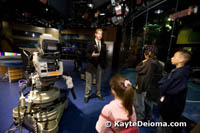
For teens and adults who are fans of NBC late night or morning television, taking a guided tour of the NBC Studios in Rockefeller Center is an interesting way to spend an hour and ten minutes on a rainy day. The tour starts with a short film giving a brief history of NBC from being the first permanent radio network in 1926, through the transition to television and the landmark programming through the years like Today, The Tonight Show, Bonanza, Cheers and Seinfeld.
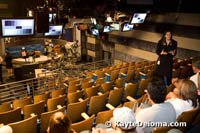 The studios available to tour vary depending on what shows are in production and what time of day it is. Early in the day, you might get to visit Studio 6A, the set of Late Night with Conan O’Brian (now Seth Meyers), and sit where the live studio audience sits during taping. Later in the day, if Seth is taping, you might see the Today Show or Dateline NBC set. On the 10:15 am tour, we got to sit in Conan’s (now Seth’s) audience seats and visit Studio 8G, where NBC Nightly News and NBC Sports are taped.
The studios available to tour vary depending on what shows are in production and what time of day it is. Early in the day, you might get to visit Studio 6A, the set of Late Night with Conan O’Brian (now Seth Meyers), and sit where the live studio audience sits during taping. Later in the day, if Seth is taping, you might see the Today Show or Dateline NBC set. On the 10:15 am tour, we got to sit in Conan’s (now Seth’s) audience seats and visit Studio 8G, where NBC Nightly News and NBC Sports are taped.
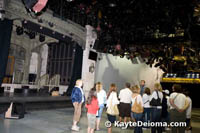 As someone who came of age with Saturday Night Live, the highlight was standing on the set of Studio 8H where comedians from John Belushi, Chevy Chase, Gilda Radner and Steve Martin to Eddie Murphy, Janeane Garafalo, Adam Sandler and Chris Rock went from unknowns to household names during their time on SNL. A myriad of Fresnels and other light panels are suspended above. Blue and yellow clap seats circle the back of the studio. Since the show was in hiatus, we got to stand in front of the actual dual Grand Central Terminal sets that have been the primary backdrop of the show since 2003.
As someone who came of age with Saturday Night Live, the highlight was standing on the set of Studio 8H where comedians from John Belushi, Chevy Chase, Gilda Radner and Steve Martin to Eddie Murphy, Janeane Garafalo, Adam Sandler and Chris Rock went from unknowns to household names during their time on SNL. A myriad of Fresnels and other light panels are suspended above. Blue and yellow clap seats circle the back of the studio. Since the show was in hiatus, we got to stand in front of the actual dual Grand Central Terminal sets that have been the primary backdrop of the show since 2003.
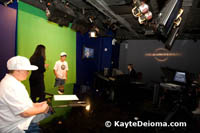 Between studios, you traverse halls lined with photos of well-known and lesser-known faces of NBC. After a quick stop in the Green Room to see where make-up magic is done, the final stop is a studio used just for tours. Each guest or group is photographed at a news desk with the New York skyline in the background. Two lucky volunteers also have the opportunity to be on the closed circuit TV. One gets to sit at the News Desk and read the news from a teleprompter. The other will report the weather from in front of a Green Screen, trying to keep track of which way to point his or her arm so it appears in the right place on the map.
Between studios, you traverse halls lined with photos of well-known and lesser-known faces of NBC. After a quick stop in the Green Room to see where make-up magic is done, the final stop is a studio used just for tours. Each guest or group is photographed at a news desk with the New York skyline in the background. Two lucky volunteers also have the opportunity to be on the closed circuit TV. One gets to sit at the News Desk and read the news from a teleprompter. The other will report the weather from in front of a Green Screen, trying to keep track of which way to point his or her arm so it appears in the right place on the map.
Tickets for the NBC Studios Tour can be purchased in advance from thetouratnbcstudios.com, or in person on the second level of the NBC Experience Store at Rockefeller Center.
TV Show Tickets at NBC
Pandemic Update: All guests must be fully vaccinated. See the ticket website below for details.
If you’d like to actually see a TV show taping at NBC in New York, free advance tickets for Late Night with Seth Meyers are available by calling the ticket office at (212) 664-3056. Stand-by tickets are available at “from 9am-10am EST at the Greeter Stand located in center of the 30 Rockefeller Plaza lobby (via the 49th & 50th St. entrances) directly in front of the Grand Stairs. After 10am EST, standby cards will be available in the Shop at NBC Studios, also located at 30 Rockefeller Plaza (via the 6th Avenue entrance between 49th & 50th St.) until 1:30pm.” Saturday Night Live tickets are available by lottery, so you can’t request a specific date. There is a virtual stand-by line via email. Check their website for details. Stand-by tickets to either show do not guarantee a seat. For these and how to get into other NBC shows, see their Ticket Information.
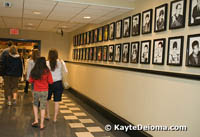 NBC Studio Tour
NBC Studio Tour
NBC Experience Store
GE Building
30 Rockefeller Plaza (corner of 49th St. Between 5th and 6th Ave.)
New York, NY
(212)664-7174
thetouratnbcstudios.com

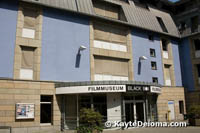 From early cave paintings, man has been fascinated with reproducing the physical world in two dimensions, and finding ways to represent the concepts of motion and the passage of time. The Film Museum in Dusseldorf takes you along on the fascinating journey of technological development from those earliest depictions of motion through the many precursors to photographic moving pictures up to the advent of moving film frames. The ground floor of the Film Museum is the Black Box Theater which shows historic and current art films. The museum exhibits begin up one level on the first floor. Although all the history is there, it’s not really laid out chronologically. Historical elements are introduced throughout.
From early cave paintings, man has been fascinated with reproducing the physical world in two dimensions, and finding ways to represent the concepts of motion and the passage of time. The Film Museum in Dusseldorf takes you along on the fascinating journey of technological development from those earliest depictions of motion through the many precursors to photographic moving pictures up to the advent of moving film frames. The ground floor of the Film Museum is the Black Box Theater which shows historic and current art films. The museum exhibits begin up one level on the first floor. Although all the history is there, it’s not really laid out chronologically. Historical elements are introduced throughout.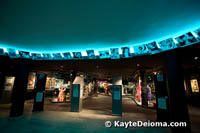 You enter through the Pantheon of Film History, a tribute to directors honoring the contributions of early Russian, Polish, Japanese, Italian, and of course, German filmmakers like Rainer Werner Fassbinder, Werner Herzog and Dusseldorf native son, Wim Wenders. Hollywood icons like Alfred Hitchcock and Charlie Chaplin are included as well. Photos circle a domed ceiling and interactive video columns allow you to watch short film excerpts.
You enter through the Pantheon of Film History, a tribute to directors honoring the contributions of early Russian, Polish, Japanese, Italian, and of course, German filmmakers like Rainer Werner Fassbinder, Werner Herzog and Dusseldorf native son, Wim Wenders. Hollywood icons like Alfred Hitchcock and Charlie Chaplin are included as well. Photos circle a domed ceiling and interactive video columns allow you to watch short film excerpts.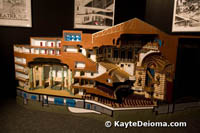 Beyond the Pantheon, the “Movie Cult – Movie Theater” room is devoted to the movie house experience. Movie posters featuring Marlene Dietrich, Greta Garbo and Ingred Bergman line the walls. There is a model of the 6200-seat Roxy Theatre in New York, the largest silent movie theater built in its day. A traveling cinema from around 1910 has been recreated and is used occasionally to show films for group tours.
Beyond the Pantheon, the “Movie Cult – Movie Theater” room is devoted to the movie house experience. Movie posters featuring Marlene Dietrich, Greta Garbo and Ingred Bergman line the walls. There is a model of the 6200-seat Roxy Theatre in New York, the largest silent movie theater built in its day. A traveling cinema from around 1910 has been recreated and is used occasionally to show films for group tours.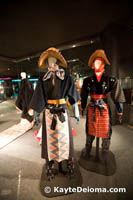 In the center of this area, period movie costumes from various international films, including Akira Kurasawa’s Dreams, are displayed in glass cases. There is also an exhibit of movie-related merchandise, from Charlie Chaplin and Laurel and Hardy memorabilia to Star Wars action figures and Disney character toys.
In the center of this area, period movie costumes from various international films, including Akira Kurasawa’s Dreams, are displayed in glass cases. There is also an exhibit of movie-related merchandise, from Charlie Chaplin and Laurel and Hardy memorabilia to Star Wars action figures and Disney character toys.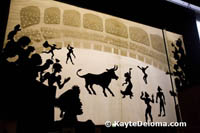 On the second floor, a collection of original shadow puppets from Turkey, China and Indonesia show how these early cut-outs were used to create the experience of watching a story take place on a screen. German filmmaker Lotte Reiniger combined silhouettes like these with film to create animated films in the 1920s and 30s. Silhouettes used in her films The Adventure of Prince Achmed, Harlekin, Carmen, and the unfinished work, Prosperina, are on display.
On the second floor, a collection of original shadow puppets from Turkey, China and Indonesia show how these early cut-outs were used to create the experience of watching a story take place on a screen. German filmmaker Lotte Reiniger combined silhouettes like these with film to create animated films in the 1920s and 30s. Silhouettes used in her films The Adventure of Prince Achmed, Harlekin, Carmen, and the unfinished work, Prosperina, are on display.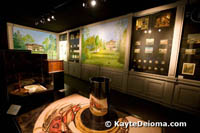 In the ” Palace of Illusions,” the press of a button changes the room lighting to show off the special effects created in 17th century “light paintings.” Back lighting allows different parts of the painting to glow, so that as day turns to night in the picture, the moon shines and lanterns and windows become lit.
In the ” Palace of Illusions,” the press of a button changes the room lighting to show off the special effects created in 17th century “light paintings.” Back lighting allows different parts of the painting to glow, so that as day turns to night in the picture, the moon shines and lanterns and windows become lit.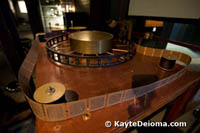 The second floor is also home to a display of the progression in development of film cameras and projecting equipment in “The Captured Outer World” and “The Projected Inner World”. The collection includes German, American, Russian and French cameras from the turn of the century through the 1980s. There is a functional replica of Le Théatre Optique, a precursor to film which projected a series of hand-painted frames on a transparent screen to simulate movement. It is sometimes demonstrated on group tours.
The second floor is also home to a display of the progression in development of film cameras and projecting equipment in “The Captured Outer World” and “The Projected Inner World”. The collection includes German, American, Russian and French cameras from the turn of the century through the 1980s. There is a functional replica of Le Théatre Optique, a precursor to film which projected a series of hand-painted frames on a transparent screen to simulate movement. It is sometimes demonstrated on group tours.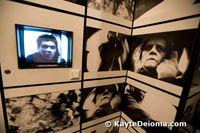 Another series exhibits demonstrates how camera angle and editing can replicate or reinvent reality. Video clips from Polish filmmaker Wsewolod Pudowkin’s short film The Mother, and Jonathan Demme’s Silence of the Lamb are shown on small screens surrounded by individual frames from the films to illustrate choices that are made in editing.
Another series exhibits demonstrates how camera angle and editing can replicate or reinvent reality. Video clips from Polish filmmaker Wsewolod Pudowkin’s short film The Mother, and Jonathan Demme’s Silence of the Lamb are shown on small screens surrounded by individual frames from the films to illustrate choices that are made in editing.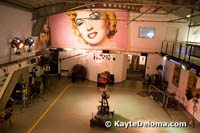 The third level takes you into the world of silent films in one room and sound effects in the next. Then pass through a film studio, where cameras, lights and a wind machine are all set to go, and a painted cardboard cutout of the back of a man in jeans and a leather jacket stands at a bar. Museum patrons used to be able to use the camera on the dolly in the middle of the room, but it has been vandalized and doesn’t work any more.
The third level takes you into the world of silent films in one room and sound effects in the next. Then pass through a film studio, where cameras, lights and a wind machine are all set to go, and a painted cardboard cutout of the back of a man in jeans and a leather jacket stands at a bar. Museum patrons used to be able to use the camera on the dolly in the middle of the room, but it has been vandalized and doesn’t work any more.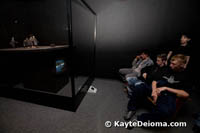 Also on level three you’ll find an introduction to animation, from graphics to “stop action”. The 1988 Academy Award winning short animation, Balance, by German bothers Christoph and Wolfgang Lauenstein, plays on a small screen underneath a platform where the original stop-action figures from the film are mounted.
Also on level three you’ll find an introduction to animation, from graphics to “stop action”. The 1988 Academy Award winning short animation, Balance, by German bothers Christoph and Wolfgang Lauenstein, plays on a small screen underneath a platform where the original stop-action figures from the film are mounted.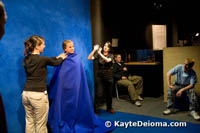 The Blue Screen exhibit lets you try out some special effects for yourself, standing in front of the blue screen and seeing yourself on television against a different background. A blue wrap lets you become a floating head or headless body, or whatever else you can dream up.
The Blue Screen exhibit lets you try out some special effects for yourself, standing in front of the blue screen and seeing yourself on television against a different background. A blue wrap lets you become a floating head or headless body, or whatever else you can dream up.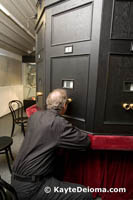 On the fourth and final floor, a Kaiserpanorama takes center stage. Invented in 1880, this ten-sided black tower surrounded by chairs has stereo viewers at each position where visitors can sit and look at black and white travel photos in 3D. Every few second, the photos inside the box rotate so you get a new view. Kaiserpanoramas were popular in Germany until the 1930s. Other technologies for three dimensional viewing from painted glassine panel sets to View Master slide-wheel viewers to holographic projections complete the exhibit.
On the fourth and final floor, a Kaiserpanorama takes center stage. Invented in 1880, this ten-sided black tower surrounded by chairs has stereo viewers at each position where visitors can sit and look at black and white travel photos in 3D. Every few second, the photos inside the box rotate so you get a new view. Kaiserpanoramas were popular in Germany until the 1930s. Other technologies for three dimensional viewing from painted glassine panel sets to View Master slide-wheel viewers to holographic projections complete the exhibit.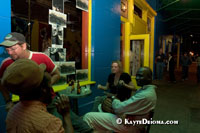 Unlike Bourbon Street, where you’ll find good music, but a great number of people are set on getting blitzed and there’s a certain sleaze factor, Frenchmen Street, located just outside the French Quarter in Faubourg Marigny, is all about the music. Although popular with locals, it has become a nightly haven for volunteers and relief workers to relax and unwind to good music after a hard day of gutting houses and trying to solve big problems. The half a dozen jazz clubs in a two block area, have a laid back bohemian feel.
Unlike Bourbon Street, where you’ll find good music, but a great number of people are set on getting blitzed and there’s a certain sleaze factor, Frenchmen Street, located just outside the French Quarter in Faubourg Marigny, is all about the music. Although popular with locals, it has become a nightly haven for volunteers and relief workers to relax and unwind to good music after a hard day of gutting houses and trying to solve big problems. The half a dozen jazz clubs in a two block area, have a laid back bohemian feel.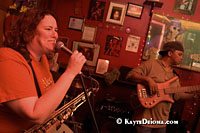 At small storefront establishments you can hear the music as well from the street out front as inside. With no cover charge, it’s easy to grab a seat or a corner of the bar to enjoy a solo drink and blend into the musical groove. At theApple Barrel I found Rebecca Barry and the FEMA No Checks, with Greg Madison on guitar and Sugar Bear on bass accompanying Rebecca’s vocals and sax. I recognized Sugar Bear from the Market Café that same morning where he had been playing with two other musicians. A couple doors down I found Sugar Bear’s morning compatriots, Pierre Pichon and Rafael Bas, playing with Java Swing at the Spotted Cat.
At small storefront establishments you can hear the music as well from the street out front as inside. With no cover charge, it’s easy to grab a seat or a corner of the bar to enjoy a solo drink and blend into the musical groove. At theApple Barrel I found Rebecca Barry and the FEMA No Checks, with Greg Madison on guitar and Sugar Bear on bass accompanying Rebecca’s vocals and sax. I recognized Sugar Bear from the Market Café that same morning where he had been playing with two other musicians. A couple doors down I found Sugar Bear’s morning compatriots, Pierre Pichon and Rafael Bas, playing with Java Swing at the Spotted Cat.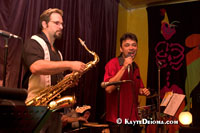 At Café Brasil on this Wednesday night, Fredy Omar con Su Banda were playing Latin jazz for fans spinning around the lightly crowded dance floor. I had met Omar a couple days before working at the Habitat for Humanity Musician’s Village building site. Omar was the first musician approved for a house at the site and he was putting in his sweat equity hours. Hanging out listening to the music, I recognized Habitat site supervisor Eli Grove. Some of the volunteers from Common Ground Relief were out on the dance floor. While New Orleans has always had a small town feel, the sparseness of the current population makes it that much more common to run into familiar faces when you’ve been in town a week.
At Café Brasil on this Wednesday night, Fredy Omar con Su Banda were playing Latin jazz for fans spinning around the lightly crowded dance floor. I had met Omar a couple days before working at the Habitat for Humanity Musician’s Village building site. Omar was the first musician approved for a house at the site and he was putting in his sweat equity hours. Hanging out listening to the music, I recognized Habitat site supervisor Eli Grove. Some of the volunteers from Common Ground Relief were out on the dance floor. While New Orleans has always had a small town feel, the sparseness of the current population makes it that much more common to run into familiar faces when you’ve been in town a week.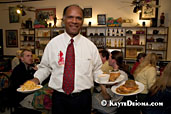 “Café Brasil is the incubator,” says Harold Toussant, a New Orleans native who waits tables at the Praline Connection, a New Orleans soul food restaurant across the street. “We know that every musician has a gift. Even if it is a little rough, people will be patient for them to develop the gift.” According to Toussant, those that have already polished their gift graduate to playing Snug Harbor, a block down and across the street. Snug Harboris known as the city’s premiere jazz club for up and coming artists as well as established names.
“Café Brasil is the incubator,” says Harold Toussant, a New Orleans native who waits tables at the Praline Connection, a New Orleans soul food restaurant across the street. “We know that every musician has a gift. Even if it is a little rough, people will be patient for them to develop the gift.” According to Toussant, those that have already polished their gift graduate to playing Snug Harbor, a block down and across the street. Snug Harboris known as the city’s premiere jazz club for up and coming artists as well as established names.